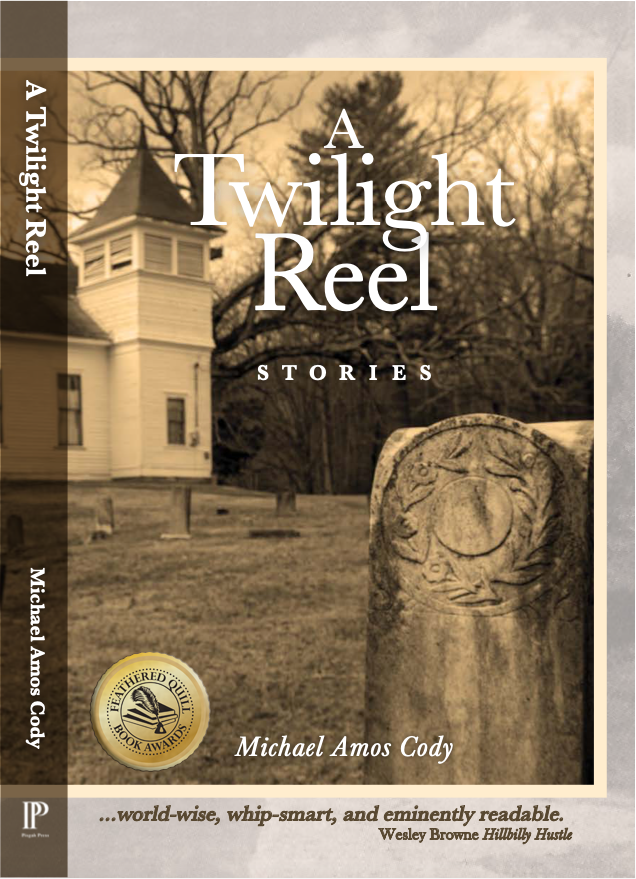a review of Michael Amos Cody’s A Twilight Reel
by Chris McGinley
Michael Amos Cody’s A Twilight Reel is simply one of the finest collections of Appalachian short stories around. In its breadth, and in its subtle evocation of theme, it recalls the work of Chris Holbrook, Chris Offutt, or Ann Pancake. Indeed, the twelve stories here are masterfully crafted. Often, they involve a dialogue with the past, with the region’s rich history, but in a manner so supremely clever and thematically purposeful, that one marvels at what Cody has achieved in the short form. Happily, though, the stories are never didactic, never archly political or self-consciously hip. No, the tales in Cody’s collection are true subtle gems, genuine pieces of art that continue to fascinate upon second and even third readings.
To wit, there are eerie stories, like “The Wine of Astonishment,” a tale about a Reverend who’s been asked to deliver a dark message to a parishioner’s odd sister, far outside of town. The trip takes a baleful turn, however, and the holy man ends up a hostage. By the end of the tale, the Reverend has a decision to make, one that may threaten the love he shares with his dutiful wife. Here Cody exhibits his gift for ratcheting up tension, and for exploring both the primal elements of desire and the less earth-bound elements of the supernatural. What’s so interesting is that one never feels that anything is beyond real in the tale. On the contrary, in fact. If the story is ultimately about a witch—and it may or may not be–well, then, witches must be real. It’s testament to Cody’s command of mountain folklore, and of regional attitudes, that raises the story above something merely “dark” or “fantastical.”
Other stories explore the relationship between the region’s past and present, like “Decoration Day,” in which Cody conducts an artful dialogue between two events: a Civil War engagement and a modern-day re-enactment of one. The events are set on the same physical terrain, a narrative arrangement that allows Cody to tie together profound sentiments from the past to that of the present. It’s a clever dance that examines the weight of history and its lasting effect on the living more than a century later. Again, it’s Cody’s understanding of the region, and of collective attitudes there, that shape the thoughtful narrative and create the engaging characters.
And that’s another thing. The reader genuinely cares about these people. It’s because Cody never writes a flat character. There’s always a sympathetic interiority he manages to convey, even in the less-likable characters. And like the finest writers, he renders these people through subtle action and dialogue. It’s in the way a man eats a buttered biscuit a woman has made for him, or the way an old woman lays her arm around her silent granddaughter. It’s in a widow’s spare words about her long dead husband, or in a father’s admission about his dying, gay son. Cody has a knack for placing kernels of action or dialogue, or for providing sparse bits of narration, that figure crucially in the aggregate. Together, the little elements give emotional depth to the characters. Again, it’s a subtle craft at work here.
Yet another thing that recommends this fine collection is the sheer breadth of types Cody has written. In the fictional Runion, North Carolina, where the action takes place, we see the entire town figure into the narrative. There are preachers, professors, business types, housewives, working class people, immigrants, rural workers . . . the list goes on. Cody’s vision is wide; he simply knows the people of small towns, all of them. He understands their hardships and their joys equally, and he has an uncanny ability to connect their varied experiences, their disparate traumas and dreams.
The twelve stories here are gems of the short form. The dialogue is crisp and real, and the narration is lovely. And there’s such a range to the writing. In fact, Cody can raise a feeling of anxiety from within an otherwise tranquil scene. Consider the following, for example:
She listened a moment longer and then stepped slowly in the direction of a laurel thicket that stood right of the path, thinking the sounds seemed to come from within the thicket or somewhere on the other side of it. Edging quietly toward the thicket’s thinner left side, she walked carefully on the carpet of long-dead brown pine needles. She knew from old memories that a small hollow lay beneath the other side of the thicket and a steep rise on the other side of that. As she approached the thinning, she began rising to her toes and craning her neck to see through laurel blossoms and leaves. Then she froze again as movement caught her eye. Through a roughly diamond-shaped opening framed by blossoms of pink and white with maroon streaks, she watched the movement of something in the gloaming almost the same color as the petaled frame.
The stories in A Twilight Reel are expertly written. Cody has given us colorful characters that ring so true to the region he represents. The work is ambitious, too. The stories explore the complicated relationship of the region’s rich history and the present. They are alternately sad, hopeful, eerie and transcendently beautiful. This is a fine collection.


Chris McGinley
Chris McGinley is the author of Coal Black (Shotgun Honey Books, 2019). He also writes for LitHub and other outlets. He lives with his wife in Lexington, KY, where he teaches middle school.

One response to “Sin & Righteousness in Appalachia”
Excellent review! So well written. Chris. And. About juch a finely crafted collection by Michael Cody.